Engineering Encounters
Animatronic Lions, and Tigers, and Bears Oh! My!
How computational thinking and 3D printing can help students create an animatronic zoo.
Animatronic Lions, and Tigers, and Bears Oh! My!
By Anna Newley, Erdogan Kaya, Ezgi Yesilyurt, and Hasan Deniz
This column describes creating a classroom culture for engineering. This issue shares information about computational thinking and 3D printing.
After a full day of teaching K–12 science, Mrs. Newley replaces her teacher hat and becomes coach of after-school robotics. In this free, eight-week, after-school enrichment club, upper elementary school students engaged and collaborated on hands-on, artistic engineering projects. Robotics can positively drive learners’ motivation, confidence, and knowledge toward STEAM and computer science (CS) (Kaya, E., Deniz, et al. 2019; Kaya, E., Yesilyurt, et al. 2019). The Next Generation Science Standards (NGSS) make a special emphasis on computational thinking and included it as one of eight science and engineering practices. In this article we describe how we taught computational thinking (see Table 1) to elementary students through a Hummingbird Robotics Kit with SNAP software.
| Computational thinking connections to the animatronics zoo project. | ||||||||||||
|---|---|---|---|---|---|---|---|---|---|---|---|---|
|
Educational Robotics
Children are natural inventors and digital savvies, and are easily inspired by creative content. Research has highlighted how extra-curricular robotics programs can foster these natural skills through robotic challenges that integrate computational thinking (CT) and science, technology, engineering, and mathematics (STEM) (Blanchard, Freiman, and Lirrete-Pitre 2010; Kaya et al. 2016; Newley et al. 2016; Nugent, Barker, Grandgenett, and Adamchuk 2009; Ozis, Newley, and Kaya 2016). This is important because to close the talent gap and keep our technological leadership, there is an urgent need to raise the number of students choosing STEM+CS careers. To reach this goal, we as teachers need to integrate CT skills and STE(Art)M into all disciplines to equip students to solve authentic real-world issues (Newley et al. 2018).
At our school, students learn coding, CT, and STEAM with Hummingbird Robotics Kits. Students are not only learning and building on new skills but also applying them in authentic robotic design challenges. Five years ago, the school received a 5,000 dollar grant to purchase the 13 Hummingbird Robotics kits. Since that time, Hummingbird Robotics Club has used the kits to make design projects with supplemental support from Donors Choose. Budget-wise, getting started with similar programs can be intimidating for teachers, but there are so many alternative ways and shortcuts. Starting with a small makerspace, using Donors Choose for materials, and using more affordable kits like Arduino, Micro:bit, Makey Makey or RaspberryPi and expanding from there might be feasible options. The joy of our Hummingbird Robotics Maker Club is how we emphasize the freedom to use the space, time, and equipment to complete students’ creative projects collaboratively.
“In the new economy, computer science isn’t an optional skill, it is a basic skill right along with the three Rs.”
Barack Obama, 2016
Hummingbird Robotics
The club is open to any upper elementary student, no prior robotics experience is needed. This club meets once a week for an hour and a half. Each meeting begins with the members stating their goals for the session and ends with a time to share reflections and achievements. In Hummingbird Robotics, activities are framed around the Next Generation Science Standards engineering design process (EDP) (NGSS Lead States 2013; see Figure 1). Throughout the NGSS EDP, students use aspects of CT to design, create, and optimize their projects. As promoted by the Computer Science Teachers Association (CSTA) and International Society for Technology in Education (ISTE) standards (See Figure 2), CT goes hand in hand with the NGSS. Some of the CT aspects covered in the project are as follows: a)Decomposition and Iterative Design: solving complex problems by resolving it into smaller manageable pieces. b)Pattern Recognition: Skimming through the problem to figure out the similarities throughout the parts of the problem and apply the already known solutions with repetition. c)Algorithms: Using step-by-step procedures to tackle the big problem. d)Abstraction: Generalizing the problem and making it applicable in other problems to make solutions faster and simpler. e)Debugging: Iteratively testing the sections of the complex problem to fix an issue and troubleshooting a problem.
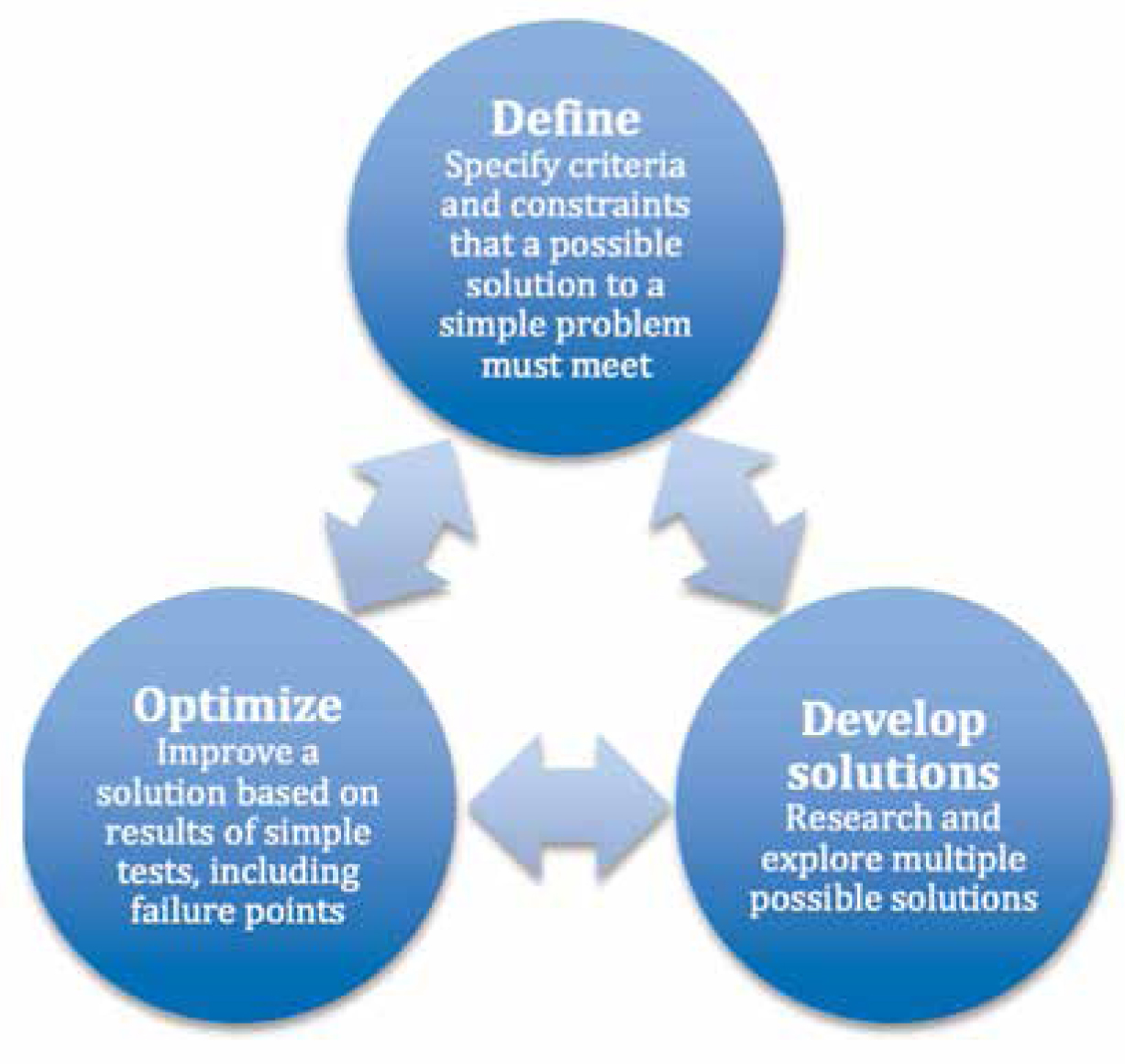
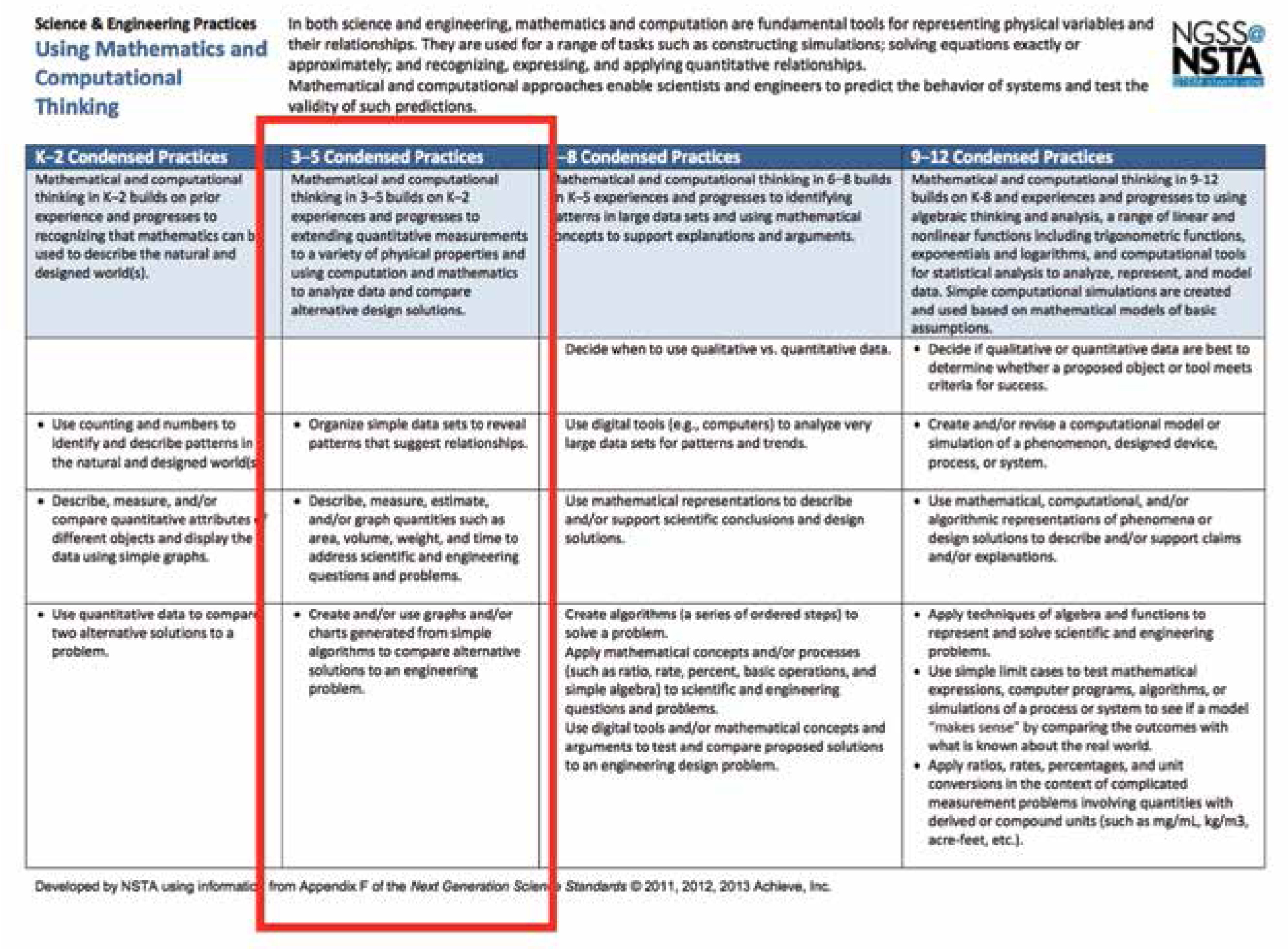
Safety
In Hummingbird Robotics Maker Club, we pay particular attention to safety since this is the first time that many students have ever tried creating anything with digital and hands-on tools. In the first meeting, we discussed the importance of wearing safety goggles, students were given a hands-on tutorial on the parts included in the kit, and students had time to practice connecting each part to the controller. As students worked in teams to practice cutting with the box cutters and using the glue guns, they reminded each other about wearing goggles and correctly handling the tools. By the end of this 30-minute lesson, students were able to independently attach/detach kit components and use tools appropriately.
Materials
The kit of parts for Hummingbird Robotics can be programmed with text-based or block-based languages so that the students are not limited by the coding language as they become more comfortable with programming. We chose to use Snap! (See Figure 3) block-based language for several reasons. Because all of the students in the club were beginning programmers, Snap’s basic interface and snap-together blocks would allow students to start programming with only a few tutorials. Snap is also browser-based or can be opened offline. Furthermore, Snap’s blocks follow a similar format to Scratch Programming language, which the students had used in their computer science classes. Any programming language that teachers or students feel comfortable using with the kit is also appropriate.
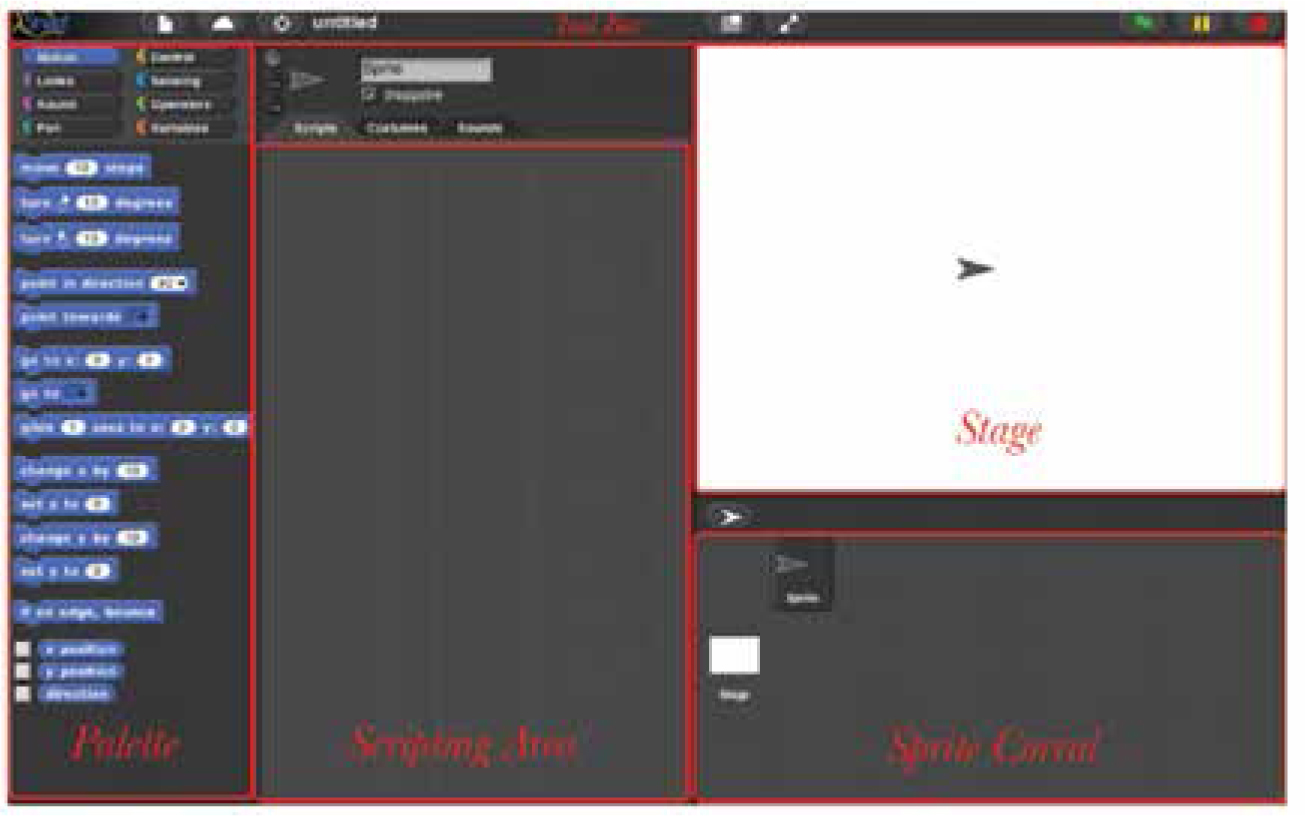
The Hummingbird Kit we use is an older version, so we have made several improvements (see Figure 4, p. 68). In addition to the motors, lights, sensors, and flat-head screwdriver originally included, we added the glue guns, box cutters, and Phillips-head screwdrivers so that students could make the most of their kits. Gear attachments for the motors can be purchased or 3D printed, but the best attachments are the ones that the students create for themselves.
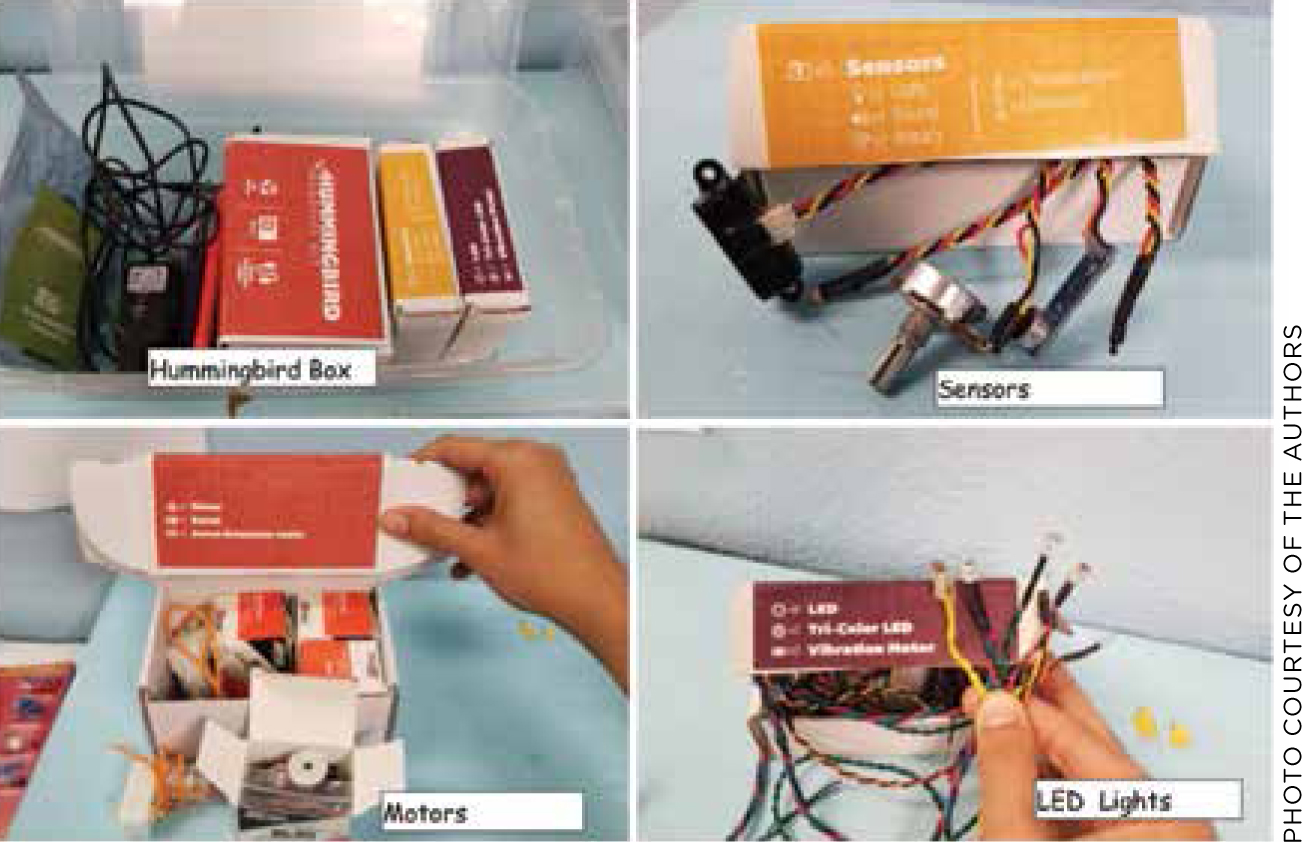
5E: Zoo Design Challenge
We used the 5E Instructional Model (Bybee 2014). It can be adapted to any discipline; we used this process to teach computational thinking with robotics.
Engage
The Engage step consisted of group discussions to gauge students’ prior knowledge about robotics, specifically where they see robots in everyday situations. Next, we moved on to algorithms, asking, “What is an algorithm?” “What do you think algorithms have to do with programming?” and “How do we use algorithms outside of programming?” Student responses provided insight into their thinking. At the start, the students had a vague understanding of what algorithms were and their importance in the real world. Because of this, Mrs. Newley integrated this vocabulary into directions, modeling, and during one-on-one assistance. By the end of the club, the students had a much better understanding. For example, when students were asked about the purpose of algorithms, responses such as “Algorithms are step-by-step processes to solve a problem,” “My mom uses algorithms when baking us delicious pastries,” “I showed my younger sister how to use algorithms by teaching her how to brush her teeth with step-by-step processes” were provided. These responses revealed students’ recognition of connections between algorithms in CS and personal life.
Explore
In the Explore phase, introductions to the kit and SNAP interface were conducted through exploration with self-paced tutorials (see Internet Resources). Teams were provided time to just play and become comfortable with the Hummingbird Kit. Then teams experimented with different art materials (i.e., construction paper, tissue paper, plastic cups, aluminum foil, pipe cleaners) to see how the LED lights interacted with the different materials’ properties. They also used supplies to test the motion of servos, DC motors, and sensors. This Explore time was focused on learning how the kit could interact with different craft materials.
Explain
In the Explain step, students shared what they learned during the exploration step and discussed some of the challenges they faced. Students decomposed problems and practiced troubleshooting them together. For example, students read their program like directions while debugging during this phase (i.e., “If distance sensor is less than 12 cm, then LED light will turn red. Otherwise, the LED light will turn green.”). Similarly, students found the patterns in their repeating codes and instead of writing the same code again and again, they used loops. It allowed us to address pattern recognition as an NGSS crosscutting concept. Throughout this step, the students learned how to overcome different programming and construction challenges from each other. While one student voiced frustration at their LED lights refusing to light, another student offered possible solutions like, “Did you plug your lights into the hummingbird controller correctly? Did you input the correct port number when adding the LED block in your script?” Additionally, the instructor answered questions and gave detailed instructions using specific SNAP and Hummingbird kit vocabulary for English Language Learners (ELL) students (see Internet Resources). During the Engage step, students received a brief overview of the kit and Snap vocabulary, but a detailed definition was provided during the Explain step and students were able to comment on how they used the kit and blocks with the words in context. This phase provided students an opportunity to step back and reflect on what they were doing and why. It helped students to express their thinking in a collaborative environment. Additionally, students who had more experience with coding helped novice students to understand the programing concepts.
Elaborate
As the Elaborate phase began, the instructor provided directions about the project description and requirements. This challenge required students to research, design, 3D print, and craft a model zoo. STEAM+CS activities need a relevant context that is connected to real-world issues. Introducing a design challenge appropriate to the level of the students is essential. Students need to conceptualize what the problem is and how they can solve the problem by using CT and EDP. After the students completed their safety and materials training and completed three to five programming lessons during the prior phases, Mrs. Newley introduced the Animatronic Zoo Challenge.
The students were introduced to the problem through a mock phone call video shot with the Google application Screencastify. In the video, a client wanted to build an animatronic zoo so that people could still learn about the animals without making them leave their natural habitat. The client wanted the students of the Hummingbird Robotics Maker Club to design a zoo and create a scaled working model for a demonstration (see Internet Resources for the challenge video). The students needed to complete the challenge by following criteria and constraints (Table 2). Students were eager to solve a meaningful problem that allowed them to help animals and preserve their habitat.
The NGSS EDP facilitated completion of the project. While defining the problem, the students used websites to gather information about five animals that would be represented in their zoo and plan the layout and kit parts for their zoo. This part of the project took about two meetings. Some of the students divided the work; one student designed the layout while another programmed. With this method, students posted comments to each other or maintained a conversation using Google Docs to get feedback or advice. Another method students used was to work together on one part, complete it, then start on the next step together. These students shared their documents online so that whatever one partner was doing, the other partner could see it real time.
After researching biomes and developing solutions, students started creating and optimizing their animatronic zoos with 3D printed animals (students used Thingiverse online community to download digital copies of 3D animal designs) and crafting materials. Schools without 3D printers can use household items, recyclables, or even old toys to create with the kits. These developing solutions and optimizing steps of the EDP happened iteratively. Students would develop a programming script for lights or motors and test it. If it worked, then students would use the glue gun or craft materials to attach an animal or zoo feature, then test again to optimize the results. If the program didn’t work, then students would seek advice from their teammate, peer in the club, or as a last resort, Mrs. Newley. The student would then modify and retest. This process continued for the remaining weeks of the club.
In the final meeting of the club, students completed their finishing touches on the animatronic models. In the forest biome, (Bottom of Figure 5) bears roar with a sensor if patrons get too close, 3D printed rabbits hop around a light-up pond, a raccoon scurries up and down a tree, and the forest glows green. In China’s bamboo forest, (Top Right of Figure 5) the animals are highlighted with colorful LED lights, a fountain puts on a beautiful light show, and pandas move around their bamboo home. In the jungle biome (Top Left of Figure 5), you can park and walk or drive your vehicle through the double doors to see gorillas with glowing eyes or dance moves. Crocodiles swim around and keep a watchful eye for visitors. Although the students wanted more meetings, all members were able to try something new. One student commented, “I didn’t know robotics could be like this; I like it.”
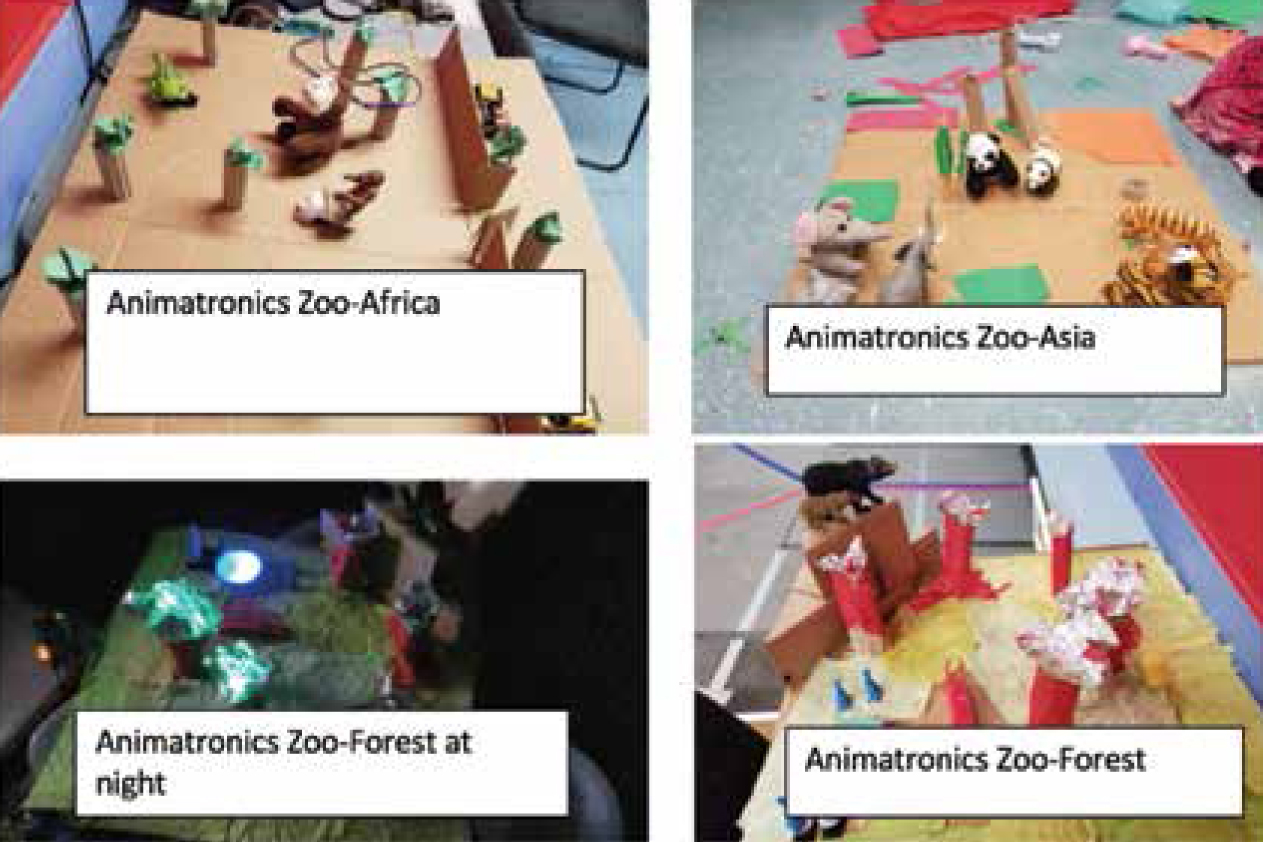
Evaluate
We summatively assessed students’ understanding of CT with Hummingbird robotics by using a programming flashcards survey (see Internet Resources) created with Quizlet. Additionally, at the end of the club, students gave demonstrations of their robots to guests at the end-of-club party. Families enjoyed refreshments while taking pictures and video of their student’s animatronic zoo projects.
Connecting to the Next Generation Science Standards (NGSS Lead States 2013)
Standards
3-5-ETS1 Engineering Design
www.nextgenscience.org/dci-arrangement/3-5-ets1-engineering-design
- The chart below makes one set of connections between the instruction outlined in this article and the <i>NGSS</i>. Other valid connections are likely; however, space restrictions prevent us from listing all possibilities.
- The materials, lessons, and activities outlined in the article are just one step toward reaching the performance expectation listed below.
Performance Expectation
3-5-ETS1-1 Define a simple design problem reflecting a need or a want that includes specified criteria for success and constraints on materials, time, or cost.
Conclusion
The main motto of our makerspace is: “People who make mistakes and learn are welcome, Failure is an option.” We know that students develop a passion for animals at an early age. We know that students love creating, making, and robots. We merged these interests in our animatronic zoo project. Our zoo engineers worked to create an animatronic zoo so that real animals could stay in their natural habitat. Students discovered their creativity and learned about the habitats and diets of different animals. Mrs. Newley comments, “I wish we could accommodate everyone! Each year we will look for more support and mentors so all students can have experience in robotics.” The zoo challenge provided an opportunity for the makerspace members to get some entry-level robotics, STEAM, and CT skills, while teaching them animal habitats and engineering.


